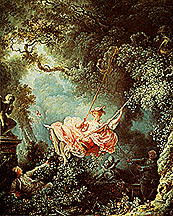The Classical Period
 From roughly 1750 to 1820, artists, architechts, and musicians moved away from the heavily ornamented styles of the Baroque and the Rococo, and instead embraced a clean, uncluttered style they thought reminiscent of Classical Greece. The newly established aristocracies were replacing monarchs and the church as patrons of the arts, and were demanding an impersonal, but tuneful and elegant music. Dances such as the minuet and the gavotte were provided in the forms of entertaining serenades and divertimenti.
From roughly 1750 to 1820, artists, architechts, and musicians moved away from the heavily ornamented styles of the Baroque and the Rococo, and instead embraced a clean, uncluttered style they thought reminiscent of Classical Greece. The newly established aristocracies were replacing monarchs and the church as patrons of the arts, and were demanding an impersonal, but tuneful and elegant music. Dances such as the minuet and the gavotte were provided in the forms of entertaining serenades and divertimenti.
At this time the Austrian capital of Vienna became the musical center of Europe, and works of the period are often referred to as being in the Viennese style. Composers came from all over Europe to train in and around Vienna, and gradually they developed and formalized the standard musical forms that were to predominate European musical culture for the next several decades. A reform of the extravagance of Baroque opera was undertaken by Christoph von Gluck. Johann Stamitz contributed greatly to the growth of the orchestra and developed the idea of the orchestral symphony. The Classical period reached its majestic culmination with the masterful symphonies, sonatas, and string quartets by the three great composers of the Viennese school: Franz Joseph Haydn, Wolfgang Amadeus Mozart, and Ludwig van Beethoven. During the same period, the first voice of the burgeoning Romantic musical ethic can be found in the music of Viennese composer Franz Schubert.
